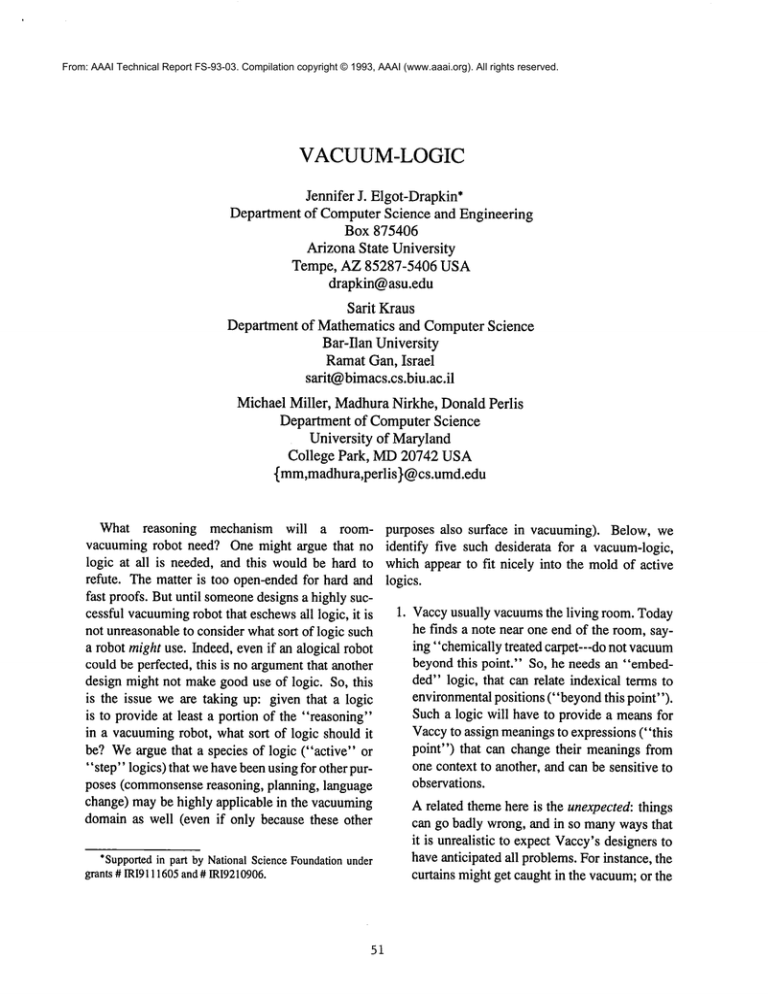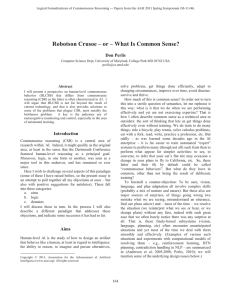
From: AAAI Technical Report FS-93-03. Compilation copyright © 1993, AAAI (www.aaai.org). All rights reserved.
VACUUM-LOGIC
Jennifer J. Elgot-Drapkin*
Department of Computer Science and Engineering
Box 875406
Arizona State University
Tempe, AZ 85287-5406 USA
drapkin@asu.edu
Sarit Kraus
Department of Mathematics and Computer Science
Bar-Ilan University
Ramat Gan, Israel
sarit@bimacs.cs.biu.ac.il
Michael Miller, Madhura Nirkhe, Donald Perlis
Department of Computer Science
University of Maryland
College Park, MD20742 USA
{mm,madhura,perlis}@cs.umd.edu
What reasoning
mechanism will a roomvacuuming robot need? One might argue that no
logic at all is needed, and this would be hard to
refute. The matter is too open-endedfor hard and
fast proofs. But until someonedesigns a highly successful vacuumingrobot that eschewsall logic, it is
not unreasonableto consider what sort of logic such
a robot might use. Indeed, even if an alogical robot
could be perfected, this is no argumentthat another
design might not makegood use of logic. So, this
is the issue we are taking up: given that a logic
is to provide at least a portion of the "reasoning"
in a vacuumingrobot, what sort of logic should it
be? Weargue that a species of logic ("active" or
"step" logics) that wehavebeen using for other purposes (commonsensereasoning, planning, language
change) maybe highly applicable in the vacuuming
domain as well (even if only because these other
*Supported
in part by NationalScienceFoundation
under
grants # IRI9111605
and#IRI9210906.
51
purposes also surface in vacuuming). Below, we
identify five such desiderata for a vacuum-logic,
which appear to fit nicely into the mold of active
logics.
.
Vaccyusually vacuumsthe living room. Today
he finds a note near one end of the room, saying"chemically treated carpet---do not vacuum
beyond this point." So, he needs an "embedded" logic, that can relate indexical terms to
environmentalpositions ("beyond this point").
Such a logic will have to provide a meansfor
Vaccyto assign meaningsto expressions ("this
point") that can change their meanings from
one context to another, and can be sensitive to
observations.
A related themehere is the unexpected: things
can go badly wrong, and in so manyways that
it is unrealistic to expect Vaccy’sdesigners to
have anticipated all problems.For instance, the
curtains might get caught in the vacuum;or the
Moreover, even a rule such as "get help in
case of fire" is too general. Vaccyshould not
seek help upon observing the gas pilot light
on the stove-top, nor a candle burning in a
well-protected glass lantern. Nor is the size
of the fire the proper criterion. A small fire
can be extremely dangerous if it is likely to
spread. Thus a substantial amount of naive
physics seems necessary, if Vaccyis to have
enough commonsenseabout his world to avoid
wasteful calls to the Fire Department.Similar
commentsapply to "get help in case of damage to living things"---for a dog and an ant do
not require equal treatment. Whetherenough
commonsense
can be axiomatized---without reverting to an exhaustive separate handling of
each special case---is a problematicissue.
dog’s tail mightinstead; the electricity might
go out; the vacuummightstart to smoke;etc. It
is all too easy to give Vaccya general-purpose
instruction to simply turn off the vacuumand
await further instructions if anything does not
go accordingto plan. The trouble is that things
almost never go exactly according to plan, and
Vaccywouldbecomeuseless if he simply stops
altogether at every minor change. So, he needs
to distinguish amongchanges; he needs to observe what transpires and decide, based on
commonsense, what to do. Now, commonsense
is not somethingthat sits on the AI shelf waiting
to be plugged into Vaccy.Onthe other hand, it
is somethingthat has been the object of intense
study, muchof it logic-based.
Our hope is that large doses of nonmonotonic
reasoningwill be useful here. For instance, there
can be axioms instructing Vaccythat certain
events are seriously abnormal(so that he should
shut downand/or seek help). These need not
be sharply specific such as referring to the dog
or curtains, but can refer in general terms to
"damage",and there can be a list of things that
it is okayto damage(small pieces of paper on the
floor with no writing on them;mud;lint; etc). In
addition, it probablyis not enoughfor Vaccyto
switch off the vacuumwhenillicit damagedoes
occur. In the case of curtain damageit maybe
okay, but not in the case of smoke,or an injured
dog-tail. Vaccyneed not knowveterinary firstaid, nor fire prevention, but he should recognize
an emergency and knowhow to call for help.
Here too logic maybe useful: phoningfor help
is a goodidea (unless the phoneis dead). Going
to the neighboris also a goodidea, but whichis
better---the phone or the neighbor?---and how
long should he deliberate between them? That
depends, again, on too many things to put
into explicit one-by-oneinstructions for Vaccy
in advance. So, we confront in fairly blunt
terms the general issue of formal commonsense
reasoning. But even more, it must be reasonably
fast as well; weretum to this below(points
and 5).
52
.
.
Another note tells Vaccy: "Vacuumcleaner is
in closet; be sure to be done vacuumingbefore noon." So, he needs a deadline-sensitive
logic, that can track the passage of time. An
ordinary temporal logic will not do: as Vaccy
vacuumsthrough the morning, reasoning about
this and that ("move the chair, avoid bumping
the vase", etc), he needs to keep his reasoning abreast of the changing time as he goes.
He cannot perform a newlightning-fast closed
episode of temporal reasoning every minute,
starting each one fresh with an updated clock.
This is because manysubtasks (change the vacuumbag, movethe table) maytake more than
minute and mayrequire re-thinking as he goes.
This is duck-soupfor active logics, since they
were originally designed for this very thing:
keepingtrack of time-passage[? 1 ;0cduringreasoning, especially for use in deadline-coupled
planning.
Yet another note, perhaps left over from last
week, says: "The vacuum cleaner is in the
bedroom,"even thoughin fact it is in the closet
as per note 2. So, he needs a contradictiontolerant logic. Perhaps he should just ignore
the mistaken note in this case---but even this
calls for a nonstandard logic: how does he
represent the messagebefore he decides it is
mistaken?Is he to take all notes as suspect until
observationallyverified?---that wouldbe a risky
approach since somenotes maybe unverifiable,
such as the one about the chemically treated
carpet. Nor of course can he take all notes as
true until falsified by observation,since notes 2
and 3 here are contradictory.
.
o
A fourth note says "Whenyou are done vacuuming, please empty the bag into the bag next
to the step-ladder in the kitchen." Vaccymust
be able to disambiguate the two uses of "bag",
what we call "semantic shift". A related ability Vaccymust have is to be able to add to his
lexicon: "step-ladder" might not be an expression he knows,so he must realize this and---if
possible---give it a meaningbased on context
(including whathe sees in the kitchen).
Moreover, Vaccy is involved in a real-world
task and one that interacts with the hectic pace
of humansociety---the room to be vacuumed
is in someone’shouse---the task must be done
in reasonably short time and must take up reasonably limited space (at least in the sense of
machinery and memoryusage). So, the vacuumlogic must avoid the usual logical omniscience
that provides infinitely manyconclusions. Inference must be fast and narrow. So somesort
of guides must contain the logic, perhapsa kind
of short-term memory.
progresses.
Onemight argue that no theoretical workis justified for a real-world agent, yet active logics, unlike
most other theoretical formalisms, are specifically
designed to go "into" a real-world agent, since
they are inherently resource-limited and tractable.
In our Workshoppresentation, we will attempt to
couch active logics in the vacuumingscenario, with
detailed axiomsand, if time permits, sample executions of implementations. Wenote that muchof the
active-logic work is already implementedin other
domains.
In the remainderof this position paper, wesketch
an English gloss of an episode of active logic inferences as might be employed by Vaccy. We have
arbitrarily taken 30 secondsas the step-grain, purely
for purposesof illustration here; the step-grain has no
built-in value in our formalismsand is quite flexible.
step # (time)
11:39:30
11:40:00
11:40:30
11:41:00
11:41:30
11:42:00
Active logics appear to have features well-suited
to all these desiderata. Already they have been
applied to default reasoning [1, 3, 2], indexicals
[4, 5], observations [1, 3], plans and deadlines [6,
7], contradiction detection and recovery [1, 4], and
semantic shift [4, 5]. While we have not applied
active logics to position-indexicals, wehave done so
for other indexicals and for meaningchangein other
settings, and we suspect the sametechniques can be
applied here. Weare currently working on a shortterm memoryaddition to active logics [7] which
will ensure the correspondence between real time
and internal clock time is maintained as reasoning
53
11:42:30
some beliefs at given
step #
Note says to finish vacuuming by noon.
It’s 11:40,20 min.left to
vacuum.
I can finish the vacuuming in 18 min.
There is enough time to
finish before noon.
I’ll get the vacuumout
of the bedroom.
Vacuumis not in bedroom, note is wrong.
It’s nowtoo late to finish
vacuuming by noon.
In this scenario, Vaccydiscovers the note to vacuumby noon; observes the current time; assesses
howlong it will take to vacuum;assesses that he
does indeed have time to finish by the deadline;
proceeds to find the vacuum;upon discovering that
it is not in the bedroom,recognizes that the note
was wrong; and then realizes he no longer has time
to finish the vacuumingjob by noon---he spent too
much time looking for the vacuum. Wesee that
Vaccymust not only be able to reason about time,
but he mustbe able to do so as time is going on. That
is, it is not only necessaryto be able to reason about
time, but Vaccymustalso---and this is critical to any
real-world agent---reason in time. It is this fundamental notion upon which the active logic research
is based.
References
[1] J. Elgot-Drapkin. Step-logic: Reasoning Situated in Time. PhDthesis, Department of Computer Science, University of Maryland, College
Park, Maryland, 1988. Available as Technical Report CS-TR-2156, Technical Report
UMIACS-TR-88-94, and through UMI order
no. 8912283.
[2] J. Elgot-Drapkin.Step-logic and the three-wisemen problem. In Proceedings of the Ninth
National Conferenceon Artificial Intelligence,
pages 412--417, 1991.
[3] J. Elgot-Drapkinand D. Perlis. Reasoningsituated in time I" Basic concepts. Journal of Experimental and Theoretical Artificial Intelligence,
2(1):75--98, 1990.
[4] M. Miller. A view of one’s past and other
aspects of reasonedchangein belief. PhDthesis,
Department of Computer Science, University
of Maryland, College Park, Maryland, 1993.
(Directed by D. Perlis.).
[5] M. Miller and D. Perlis. Presentations and this
and that: logic in action. In 15th AnnualConference of the Cognitive Science Society, Boulder,
Colorado, 1993.
[6] M. Nirkhe, S. Kraus, and D. Perlis. Fully
deadline-coupled planning: One step at a time.
In Proceedingsof the sixth international symposium on methodologies for intelligent systems,
Charlotte, NC, 1991.
[7] M. Nirkhe, S. Kraus, and D. Perlis. Situated
reasoning within tight deadlines and realistic
space and computation bounds. In Common
Sense 93, Austin, Texas, 1993. Also to be
presented at the IJCAI-93 Workshopon Spatial
and Temporal Reasoning.




